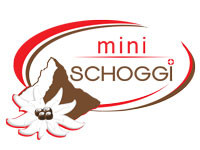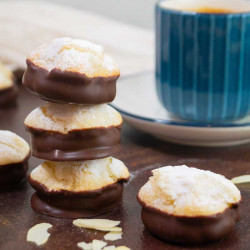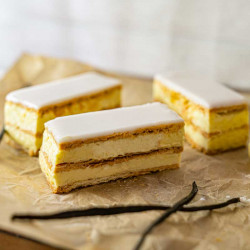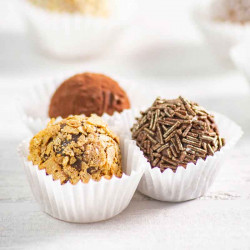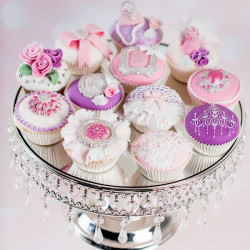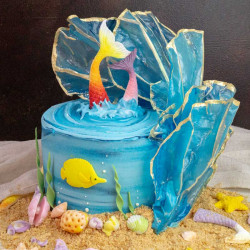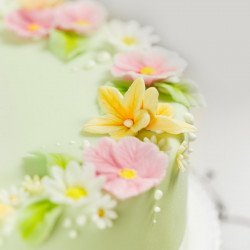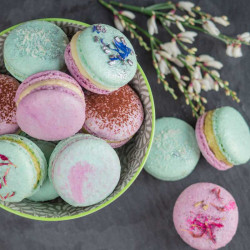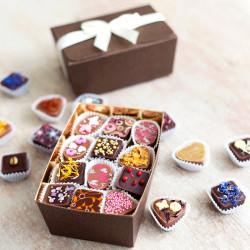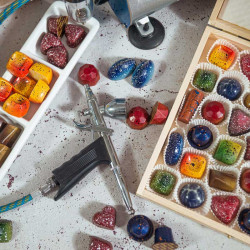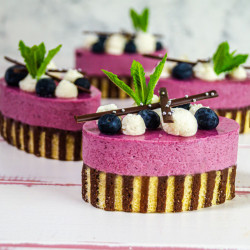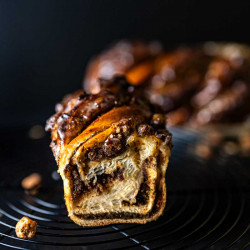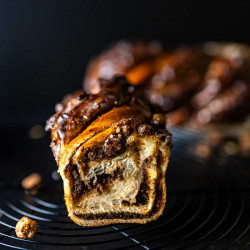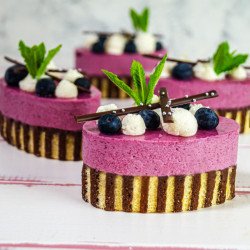Courses in Zurich - Adliswil
Courses in Zurich Adliswil
Zurich is known by many as the economic center of Switzerland, as a banking and trading city, and as the seat of the ETH. But the beautiful city has much more to offer - especially culinary.
Even though Zurich is not exactly known worldwide as a stronghold of culinary delights, there are some tasty treats to be discovered here. In addition to Züri Gschnetzletem and Emmentaler, many sweet specialties are also sold. And at one place you can even learn how to make the many delicacies at home.
Welcome to miniSchoggi
Just 20 minutes by train from the main station, you will find the miniSchoggi course, event and store. Courses are held here daily, where anyone can learn how to safely create perfectly shiny chocolates, crispy breads, airy macarons and much more.
Listing of all courses
Also teams of different companies, children's or poltergeist groups spend sweet hours in the premises in Adliswil again and again.
Listing of all events
All courses and events are always led by a specialist - whether a confectioner, pastry chef, baker or food technologist. In this way, we guarantee the best quality and optimal advice. Thanks to professional training and many years of professional experience, our course instructors can answer (almost) all your questions and give you lots of tips and tricks for the individual creations.
In addition to great courses and events, you will also find over 3500 products for passionate bread bakers, hobby confectioners and home chocolatiers in Adliswil. So you can also stock up with the necessary materials for production at home directly after your course.
Here you also benefit from professional advice. Our confectioners will be happy to help you find the right ingredient and give you tips so that your next creation is sure to succeed. In this way, you can create delicacies at home that are in no way inferior to the Zurich confectioners in terms of quality, taste and appearance.
Zurich confectioneries
If you're out and about in Zurich and looking for a sweet treat, you'll quickly find what you're looking for. Various large and small confectioneries offer products of the best Swiss quality here.
A very special company, which among other things also produces various confectionery products, is the St. Jakobs Foundation. Here, impaired people are given a workplace adapted to them, giving them the opportunity to develop in a suitable environment and to pursue a fulfilling profession. In addition to sweet chocolate figures and fine chocolates, the traditional Züri Tirggel are still produced in this factory.
Honold is one of the great confectioners in Zurich. In 1905, Fritz Honold-Herzog took over the confectionery business of his former employer Rudolf Meier and bought a house on Rennweg in Zurich. One of seven confectioneries in and around Zurich still stands there today. Honold offers a wide variety of products, from bread to cakes and pâtisserie to chocolates.
In Maschwanden (Zurich), another company found its start in 1920. Ten years later, the Kleiner Bakery-Confectionery then also spoiled the people of Zurich with its delicacies. Nowadays, you can enjoy delicious breads, ice-cold glaces or beautiful cakes in seven branches. In addition, this bakery bakes real traditional offal.
Confiserie Sprüngli
Probably the best known confectionery in Zurich is Confiserie Sprüngli. There are 17 of these confectioneries in and around Zurich, with the headquarters located on Paradeplatz. Sprüngli is also represented in other cities in Switzerland with a total of eight locations. The confectionery was founded at Paradeplatz in 1862. Nowadays, the noble Luxemburgerli are particularly well known. The Luxemburgerli are macaron-like pastries with a sweet filling. In the Sprüngli confectioneries, the colorful treats are often piled up in small pyramids. Alongside them is a large selection of chocolates and other chocolate products. But what many people don't know is that Confiserie Sprüngli is not part of the chocolate manufacturer Lindt & Sprüngli.
Lindt & Sprüngli GmbH
With Sprüngli et fils, David and Rudolf Sprüngli opened the first chocolate factory in German-speaking Switzerland in Zurich. Just two years later, a second chocolate factory in Horgen began production. Twice a week, Sprüngli visited the Horgen site on foot to see how things were going. In 1862, additional sites were purchased. These included the Tiefenhof on Paradeplatz. It was there that the Confiserie Sprüngli et fils was established. Here, a hot chocolate could be drunk and something sweet enjoyed.
Solid chocolate was not yet a typical specialty at that time. It was the conching process invented by Rodolphe Lindt that transformed the previously tough brown mass into the melt-in-the-mouth Swiss chocolate we know today. Twenty years after inventing this processing method, Lindt sold his chocolate factory and the recipe for chocolate fondant to Johann Rudolf Sprüngli. The latter had inherited the chocolate factory of his father Rudolf Sprüngli seven years earlier. Confiserie Sprüngli went to his brother David Robert Sprüngli, and the two companies have been separate ever since.
In the meantime, Lindt & Sprüngli has become a world-renowned company with production facilities in various countries. The factory produces various chocolate bars and hollow figures, but much better known are the chocolate Gold Bunny, which fills the shelves at Easter, and Lindor balls, which are enjoyed all over the world.
Become a hobby confectioner yourself
The noble creations of the confectioners are gladly admired in the shop window and when enjoying a fresh loaf of bread, one often wonders how such a crispy crust is achieved. We give you an insight into the sweet world of chocolate, the art of confectioners and the oven-fresh baking world.
Züri's specialties
Now the confectioneries are named, but what do you actually sell? Zurich specialties are, for example, banking and Züri Gschnetzlete, but neither one nor the other belong in a confectionery. But don't worry, Zurich also has a lot to offer in the sweet sector.
Luxemburgerli
Small, sweet and colorful, the macaron-like treats adorn the shop windows of Sprüngli Confiserien. They come in a wide variety of flavors and colors. However, the little double-deckers are more difficult to make than their appearance suggests. Only the right ratio of stiffly beaten egg white, very finely ground almond flour, sugar, natural coloring and flavoring produces perfect crispy but not hard macaron shells.
Baking is also an art in itself, because the shells must be given a so-called foot, must become firm, but must not crack or remain rubbery inside. If the shells are finally successful, one side is covered with a delicious buttercream or chocolate ganache. Depending on the occasion, a little jam or jelly is added to the center of the ganache ring to give it a fruity touch. Finally, the second shell is placed on top and lightly pressed on. This way, the little nibble is also ready to be eaten. It is best to do this on the second and third day after making them, because that is when they taste best. If you leave them longer, the shells slowly become tougher and less crunchy.
Thus, the Luxemburgerli are very exclusive and high-quality confectionery products. Since they are made without artificial additives and exclusively with natural flavors and colors, you do not stay fresh forever, but you know what you buy or give away. In addition, the macaron shells are still dressed by hand due to your demanding production.
The connoisseurs of pâtisserie and pastries have certainly noticed that the production of Luxemburgerli is the same as that of macarons. In fact, these two pastries are almost identical, the only difference is the size. While a macaron can range in size from about six to one centimeter, the Luxemburgerli patented by Sprüngli have a diameter of about 2.5 cm.
Luxemburgerli owe their name to a confectioner from Luxembourg. In 1957, Camille Studer brought a new recipe to Switzerland. Together with Richard Sprüngli, Studer worked on the perfect recipe for a long time. The little treats could already be bought in the confectioneries of Zurich. However, since the originally French pastry was still rather unknown and the chosen name was not very popular, the people of Zurich only asked for the "Luxembourg pastry" or Luxemburgerli.
If you want to learn how to make the big relatives of the Luxemburgerli, the macarons, we welcome you in our bakery. In Adliswil you can make your own macaron paste and bake and decorate them under the guidance of a professional confectioner. Once the macarons are perfectly baked, they are filled with delicious creams and ganaches. With a recipe booklet and many tips and tricks from the course leader, you are then perfectly equipped to make crispy airy macarons with perfect feet and fillings at home.
Trouser buttons or patience tentli
At first glance, these pastries also remind a little of the Luxemburgerli. The half shells are about one centimeter in size and very hard. Unlike their similar-looking relatives, they do not bear colors, they are beige or yellowish in nature. They also do not offer the same variety of flavors. The Zeltli are flavored with bergamot oil and their consistency is more reminiscent of extremely hard meringues than macaron shells.
They probably owe their name to this very consistency. On the one hand they are small, round and hard like trouser buttons, on the other hand it takes patience to make them and also to enjoy them. The dough of egg white, flour, powdered sugar and bergamot oil is spread on a mat and then left to dry for up to four days. Only then are they baked very briefly with pure top heat. If you then let them melt slowly on the tongue, they develop their full flavor aroma.
Geduldszeltli originally came from Basel, but evidence has been found to show that they were made in Zurich as early as 1870. What is particularly impressive here is that the recipe has remained extremely constant since then. While chocolate and macarons are constantly being recombined and developed, the secret of Geduldszeltli lies in their consistency.
While the trouser buttons are enjoyed today mainly as a souvenir or small treat throughout the year, they used to be made especially for the Advent season. However, they are still a niche product even as a specialty. Based on various recipes and written testimonies, it is believed that Geduldszeltli used to be bought mainly by the lower social classes. The hard shells were tasty, sweet and cheap, and they also had a long shelf life. In the wealthy homes offleten were served in their place.
Hüppen and Offleten
An offlete is a large, round, wafer-thin crisp baked dough, often embossed with a coat of arms. The mounds are almost identical, the offlete only needs to be rolled, the embossing is unnecessary.
The Offleten are already very old, originally they originated from the hosts of the monks. From the 16th to the 18th century, the pastries were known in many parts of Switzerland, today they are a Zurich specialty. With the Hüppen however above all the Gottlieber Hüppen from the Thurgau attained fame.
Already before their heyday, the Offleten and Hüppen existed for a long time. They were used primarily as festive pastries and on occasions of the guilds. Here the Hüppen were a sweet treat for everyone, the Offleten with the noble embossed coats of arms were reserved for the fine families.
This was probably due to the fact that operating the heavy waffle irons for stamping required a lot of dexterity and strength. The dough, which is poured onto one side of the waffle iron, consists of flour, milk, powdered egg yolks and sugar. In the past, honey was used instead of sugar, another reason why the offleten and Hüppen were among the more expensive delights for a long time.
Nowadays, there are sweet as well as salty offletes. For this purpose, almonds, more sugar, cinnamon, pepper, salt or grated hard cheese are added to the dough. Since the Offleten are also a niche product, today they are only made by the Kleiner Bakery-Confectionery. For this purpose, they use a large machine with four heatable plates, a unique piece from the 1980s. The liquid dough is poured onto one plate, and the second plate presses down. At 170 to 175, and even 180 °C for salty doughs, the offlets are baked. Then the rotating plates open again and a finished offlete can be taken out. They are then sold in tins of 20 pieces each.
Hüppen are easier to make nowadays and also much better known. The dough is baked flat and automatically rolled onto a stick while still hot. By cooling the Hüppe becomes hard, can be packed and enjoyed with coffee, tea or ice cream.
A lot has changed since the first Zurich recipe by Anna Margaretha Ziegler in 1693. Some ingredients, such as honey, have been replaced, the baking technique has been adapted to modern machines and quantities have been slightly changed, but probably the most significant innovation is the filling.
In 1928, the Hüppen production opened in Gottlieben. Hüppen are still baked here today and filled with various delicious ganaches and creams. This is usually a differently refined and flavored gianduja filling. In contrast to the Offleten, the Hüppen in this form have become world famous.
Tirggel
Tirggel is a very well-known traditional cookie, which today is only produced by a few companies, such as Biscuits Sutter AG, the St. Jakobs Foundation or Midor. Despite its complex production, the long-lasting honey cookie is also sold in Migros and Coop. But first back to the beginning.
Hard pastries with honey have existed for a long time, but the first time the name Tirggel appears in a modified form is in the 15th century on a document. This was a criminal sentence, a woman was sentenced to death as a witch, because she had broken off a piece of Tirggel and given it to a boy to eat.
Due to the spices contained in the dough, the pastry was said to have a healing effect. The high honey content, which can be up to 30%, is another reason why the Tirggel was considered a luxury item even in the past. Further, the production of the embossing was also very labor-intensive and energy-sapping.
The dough, consisting of honey, flour, spices and sometimes a little water, first had to be kneaded for a long time and then rolled out as thinly as possible. This flat sheet of dough was then placed on a model, a hand-carved negative mold made of wood. With the fingertips and the heels of the hands, the dough then had to be pressed in so that later really all the details were visible.
Of course, nowadays large mixing and kneading machines are used for the dough and hygienic models and rollers for embossing, but still a lot of manual work is required when it comes to high quality tirggel.
The dough, rolled out to two millimeters by means of rollers, is rolled onto a wooden stick and placed with it on large models. After rolling over it several times with another roller, the excess dough is cut off. Now the task is to highlight the details of the shape. With the fingertips, the dough is once again better pressed into the mold. Turned over and removed from the mold, the individual tirggel are cut out. The tirggel is then flamed for 90 seconds at pure top heat. This gives it a nice brown surface, but does not lose the light bottom.
These traditional pastries are still enjoyed today, especially during the winter season. The spices and honey make for a real treat when you let a piece of Tirggel melt in your mouth. Visually, the Tirggel is also very appealing with its diverse motifs. Nowadays, typical Zurich motifs, such as the Gross- or Fraumünster, often decorate the pastry. In the past, images of guild professions were also very popular. Each bakery had its own models and proudly presented the individual Tirggel. Since these are hardly used today, some of them can be admired in museums, for example the Swiss National Museum.
If you would like to make this luxurious pastry yourself and bake a real, traditional Tirggel, we would be delighted to have you visit us. In the miniSchoggi bakery you can hold your own Tirggel event with your team, family or friends. This is a great way to enjoy the tradition.
Züri treat
Last but not least, we turn our attention to the Züri Leckerli. Everyone knows the Läckerli from Basel, but anyone expecting something similar in Zurich is sorely mistaken. Instead of a chewy honey pastry with candied fruit, here you get a juicy confection reminiscent of marzipan. With a noble embossed motif, the treats are also visually very appealing and make an excellent gift or souvenir.
The treat dough is made in some traditional flavors. These include orange, cocoa, hazelnut, cinnamon and the typical almond flavor. The finished dough is rolled out to one centimeter thick and pressed into the embossing mold cut into pieces.
After a 24-hour drying process, they are flamed for three to five minutes, i.e. baked with pure top heat. Fresh from the oven, the treats are glazed while still warm. This gives them a particularly beautiful shine later on.
Despite their delicious taste, delicate consistency and classy appearance, Zurich treats are by no means as well-known as their Basel namesakes. They are considered a niche product, but are definitely a great souvenir or souvenir from Zurich.
Visit us in Zurich Adliswil
As you can see, Zurich has a lot to offer, a visit is worthwhile for every sweet tooth and every bon vivant. While in the city you are provided with a variety of traditional treats, only 20 minutes away in Adliswil we spoil you with creations from all over the world and a lot of interesting knowledge. In our course rooms, you will learn everything you need in terms of knowledge and tricks to become a confectioner, a chocolatier or a baker at home in various courses.
In our event rooms we welcome you with your team, your family, the wedding party or even a whole "Ragglete" of children to a team event, an extraordinary occasion or a children's birthday party. In the bakery it smells of bread and Tirggel, in the vintage room noble cupcakes and cookies are decorated, in the chocolate studio and the chocolate workshop is "gschöggelet" and in the land of milk and honey the children can let off steam.
In Adliswil we offer something for every taste, see for yourself!
